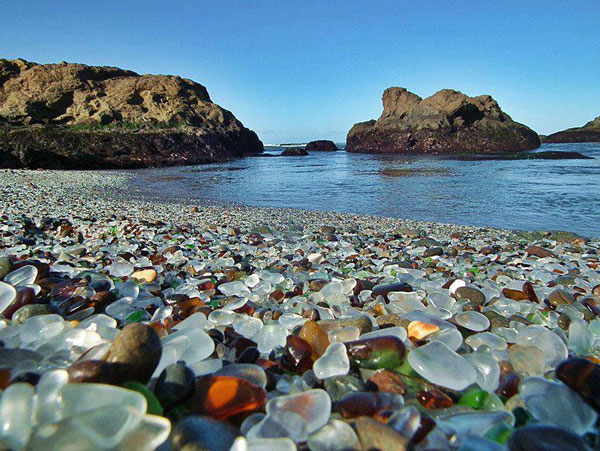High-Tech Treasure Hunting: How to Detect Gold

Of the articles I have written for this magazine, Looking into the Earth for Artifacts and Placers generated more interest than all others combined. People called and wrote me from Sweden to Indonesia and from Alaska to Spain. Requests beyond finding treasure and placers covered things from permafrost-preserved mastodon ivory to carrots(?) and unexploded bombs. Knowing what you readers want, this article condenses a chapter from my new book: Treasure – the Business and Technology. Detection and analytical problems in marine archaeology are close to those of placer mining. Old marine treasure sites are weather-induced deposits of precious metals and gems. Techniques like high-resolution geophysical acoustic imaging, neutron activation analysis, and optical microscopy of core bores apply to each.
Much garbage is out regarding detection tools, but the solutions exist. They are found in fields like geophysics, chemistry, optics, spectroscopy, radiology and industrial, non-destructive testing. NEVER spend money on unexplained detection technology. When a method is explained, verify it with third parties–medical radiologists and industrial engineers are a good place to start.
At the start of last year’s treasure season, a meeting of scientists and engineers with expertise relating to treasure detection was held in Fort Pierce, Florida. Organized by Mel Fisher, the group represented the commercial treasure hunting community, academics, and professionals in oil and mineral exploration tools. The discussion was open and lively. Dr. William Pelton, Ph.D., a Denver geophysicist, conducted the meeting and was quick to separate the wheat from the chaff.

This conference represented the best detection expertise ever made available to treasure salvors. In preparation for the meeting, Dr. Pelton charted detection methods and effectiveness for specific problems (chart on opposite page, reprinted with permission).
I had become “hooked” on treasure after seeing the Atocha treasure and meeting with Mel Fisher in 1985. Here was a new business with multi-billion dollar potential, yet there was so much that could be done to improve it. I began an intense research effort on treasure detection, knowing every single piece of information (even negative) would have a future value, and stayed in contact with Fisher.
My first reaction to the chart on the wall at the meeting was one of paranoia–“Who had leaked the work that I had been doing for the past 5 years?!” As it turned out, Bill Pelton is the Chairman of Phoenix Geophysics, Inc. [Denver] and needed no help to prepare his chart. His clients have included BP, Shell, Amoco, Rockwell and Sandia National Laboratories, to name a few.
Over several hours, I became relaxed. It was apparent at the meeting that scientists do not understand the shipwreck business, and that the treasure salvors did not understand detection sciences. In fairness, one can only learn so much in a lifetime. Marine archaeology is as complex as building airborne, induced-polarization equipment for mineral detection in mountain ranges.
Treasure exists in documented billions under the ocean bottom! The problem is that treasure sinks to bedrock and historically it has not been cost-effective to dig up all of the overburden over old marine treasure sites, especially partially salvaged ones, even when there are tens of millions of dollars worth of treasure roughly located within a square mile according to historical data. The “scatter patterns” often contain millions of cubic yards. A square mile, with 10 feet of overburden, contains over 10 million cubic yards. If your treasure is over $100 million retail, but you must excavate to find it, a $30-40 million ($3/yard) excavation budget is probably not a break-even deal! Once located, however, treasure can almost always be excavated profitably.
There are countless numbers of famous sites that fit this category. The last one I heard about that was “located” but unsalvaged is the Flor de la Mar: Portuguese, sunk 1511, Malacca Straits (between Indonesia and Singapore). This wreck contained one third of the spoils from the conquest of the Sultanate of Malacca (now Singapore). By most estimates, her treasure is worth over a billion dollars, and some (particularly the potential salvagers) claim it may go as high as 7-9 billion! Here’s the problem, as reported in a newspaper article faxed to me from Indonesia on April 2, 1991:
“When located, the wreckage of the Flor de la Mar, scattered over a 250,000 square meter area, was eight kilometers to the north of Jambo Aye Cape between Medan and Banda Aceh cities and was buried in hardened sand and mud some 18 meters deep.”
The Flor de la Mar site is 62.5 acres by this account and is probably much longer than it is wide, e.g. 50 by 5,000 meters, and probably irregular! Assuming these data to be correct, there are over 6 million cubic yards on the site. The costs of excavating more than 15-20 feet under the bottom are very high. I know from personal experience that it costs over $100,000 to excavate wet soils for an area 15 x 17 x 40 deep [400 c.y. @ $250/yard], with modern equipment and working from dry land!! Under the ocean, in a remote area of Indonesia, working from a moving salvage vessel, the cost may be $1,000/ cubic yard or more.
To excavate the whole Flor de la Mar site, therefore, could cost 6 billion dollars!
Treasure hunters have talked about the application of high-tech methods to their business, but to date, most still drag a magnetometer, blow a hole with propwash deflectors, and then use a metal detector and physical inspection. Side-scan sonar has produced some results [e.g. the Central America’s 3 tons of gold], but most treasure is under the bottom, out of reach for side-scan.
If one understands the varying and complex fields involved in marine archaeology, and has the budget to buy and modify off-the-shelf geophysical detection tools, the process has barely started. With state-of-the-art detection tools plus necessary additions, combined with techniques from the sciences and the discipline to use them, it is still necessary to accomplish three major feats to apply high-tech methods to treasure hunting:
Base-line data for each tool and technique must be obtained.
The data must be integrated.
The methods must be seaworthy and cost-effective.
Detection tools and scientific tests produce numbers and squiggles on charts. “Base-line data” is the benchmark information against which any acquired data must be measured to be meaningful. Example: It is well-known that there is gold in sea water, and that several analytic techniques can detect it to parts per billion. What are the particular levels of gold in the sand and water in your particular search area? What does the elevation of several parts per million in gold content in samples mean? Does the increase mean that the samples were taken close to a treasure wreck? Might the increase be just a random increase in background levels? Sand moves. Where was the sand in your samples 300 years ago?
My hypothesis is that a treasure site can be located by detecting trace amounts of precious metals in the sand from 1/4 to l/2 mile away. To date, no one has completed a good chemical analysis of a single treasure wreck site. We have started the first, but it is a simple, brute fact that analyses of samples from several undisturbed treasure wrecks will need to be done in order to generate predictive validity of chemical detection of wrecks.
Data “Integration” is a powerful, high-tech process: combining results from multiple detection methods where the whole is more meaningful than the sum of the parts. Data integration is the most cost-effective approach. Example: Once we know that there is above-background gold and silver in an area where we are looking for treasure (chemical analyses showing parts per million vs. parts per billion or trillion), we apply a combination of electromagnetic (EM) and acoustic detection methods to look into the bottom.
We are currently building ultrasonic, 3-D, high resolution, sub-bottom imaging equipment using better computer mathematics than the 2-D ultrasound that sees babies in mothers wombs. Thus far, the highest-tech treasure hunters only use ROV’s with multiple video monitors and color side-scan. Our choice is ultrasonic (high-frequency acoustic) imaging combined with EM to discriminate ferrous and non-ferrous metals. We claim we will achieve 1/4″ resolution of artifacts and physical features 20-30 feet under sand and rock. This equipment will answer the questions: “Where are the gold coins in a 20 acre scatter pattern?” and “Where are the pockets in the bedrock that have the gold nuggets?”
If we see something on a wreck site that is round with a high, ferrous EM spike, it is probably an iron washer. If it is round, resonant, in an area where high silver sulfide concentrations have been found, and has a weak or no EM spike, it is probably a several hundred year old silver coin. This is the “data integration” process. The rock-bottom objective is to know with a high degree of certainty that we want an object before digging it up. These are the most cost-effective methods, once fully understood.
IMPORTANT ECONOMIC POINT: Data acquisition costs (labor, travel, vessels, overhead, etc.) are almost always much greater than detection tool costs. Never do a project with bad detection tools!
The high-tech, integrated approach to treasure requires that a wide range of technical data [optical, acoustic, electromagnetic, chemical, archival] be “rubber-sheeted” in a computer into a single “picture”, perhaps starting with a high-resolution aerial or satellite images.
Dr. Pelton’s chart is state-of-the-art for available geo-technical exploration equipment, versus the theoretical limits for the techniques. Our research has extended the chart, and the revisions indicate the detection areas that we feel hold the greatest promise for the treasure business. There are some tools that we have seen that are not included on the chart, but which also have promise. One example is down-hole spectroscopy, developed by the military as a toxic waste dump investigation tool. Strain and resistivity are measured by a probe that has a sapphire window in the side. A laser beam is guided down a fiber optic cable which then exits the side of the probe.
A portion of the laser light returns topside via the fiber optics to a spectroscope for remote analysis. The down-hole spectroscope may have application for treasurea probe to examine the chemistry of a ballast pile. The dry-land version used by the DOD was developed at a cost of $l million, but it should be possible to develop an effective wreck site probe for only tens of thousands.
Some techniques we have quit investigating. On-site neutron activation is good for many applications. This very sensitive method is used by Kodak to monitor the effectiveness of their silver reclamation, but it has too many problems to be cost-effective in the field: burdensome government regulation, export/import problems, expensive technical labor and complex equipment with potential for lengthy down-time.
This article, and the book, can only present techniques in sufficient depth to point the way to others with an interest in the field. To get you started in a library or research laboratory, and to cover the topics in depth to the next levels would require a book the size of The Mechanical Engineer’s Handbook (2300 pages which still does not cover the whole story of mechanical engineering). Rather than keep what we are doing secret, we invite competition. If you can take this basic information on treasure and run with it–good luck to you. The successes of others give credence to our own efforts and there is enough treasure for everyone who has the ability.

